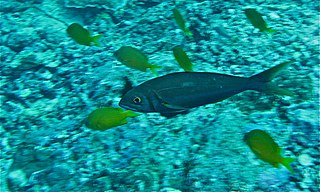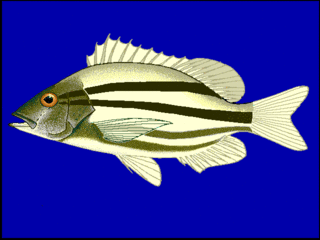
Macolor is a genus of marine ray-finned fish, snappers belonging to the family Lutjanidae. They are native to the Indian Ocean and the western Pacific Ocean.

The bigeye snapper, also known as the bigeye seaperch, red sea lined snapper, golden striped snapper, rosy snapper, yellow snapper, or simply snapper, is a species of marine ray-finned fish, a snapper belonging to the family Lutjanidae. It is native to the Indian Ocean and the western Pacific Ocean. It is the type species of the genus Lutjanus.

Lutjanus is a genus of marine ray-finned fish, snappers belonging to the family Lutjanidae. They are found in the Atlantic, Indian, and Pacific Oceans. They are predatory fish usually found in tropical and subtropical reefs, and mangrove forests. This genus also includes two species that only occur in fresh and brackish waters.

The sailfin snapper, blue-lined sea bream or blue-lined sea perch is a species of marine ray-finned fish, a snapper belonging to the family Lutjanidae. It is native to the Indo-Pacific region. The sailfin snapper is targeted in mixed-species fisheries throughout its range. In areas such as the Philippines it is known to be overfished, while in others, for example Palau, pressure is lighter. It is caught predominantly using handlines and bottom trawling. The juveniles appear in the aquarium trade. It is currently the only known member of its genus.

Apsilus is a small genus of marine ray-finned fish, snappers belonging to the family Lutjanidae. The two species within the genus are native to the Atlantic Ocean,

Etelis is a genus of marine ray-finned fish belonging to the family Lutjanidae, the snappers. They are mostly native to the Indian and Pacific oceans with one species (E. oculatus) native to the western Atlantic Ocean.
The scalemouth jobfish, also known as the scalemouth snapper, is a species of marine ray-finned fish, a snapper belonging to the family Lutjanidae. It is native to the Pacific Ocean. This species is the only known member of its genus.

Pristipomoides is a genus of marine ray-finned fish belonging to the family Lutjanidae, the snappers. They are found in the Atlantic, Indian and Pacific oceans.

The Chinamanfish, Chinaman snapper, galloper or thread-finned sea perch, is species of marine ray-finned fish, a snapper belonging to the family Lutjanidae. It is found in the Western Pacific Ocean.

Aphareus furca, the small toothed jobfish, blue smalltooth jobfish, fork-tailed snapper or snapper jobbyfish is a species of marine ray-finned fish, a snapper belonging to the family Lutjanidae. It is found in the Indo-Pacific region.
Pristipomoides typus, also known as the sharptooth jobfish, white snapper, white jobfish, goldband snapper or threadfin snapper, is a species of ray-finned fish, a snapper belonging to the family Lutjanidae. It is found in the Indian and Pacific Oceans.

Pristipomoides sieboldii, the lavender jobfish, lavender snapper or von Siebold’s snapper, is a species of ray-finned fish, which is a snapper belonging to the family Lutjanidae. It is found in the Indian and Pacific Oceans.
Pristipomoides flavipinnis, the golden eye jobfish or golden eye snapper, is a species of ray-finned fish, a snapper belonging to the family Lutjanidae. It is found in the Pacific Ocean.

Pristipomoides auricilla, the goldflag jobfish or the yellow flower snapper, is a species of ray-finned fish, a snapper belonging to the family Lutjanidae. It is found in the Indo-Pacific region.

The African forktail snapper, is a species of marine ray-finned fish, a snapper belonging to the family Lutjanidae. It is found in the eastern Atlantic Ocean.

Aphareus rutilans, the rusty jobfish, ironjaw snapper, red smalltooth job, silvermouth or small tooth jobfish, is a species of marine ray-finned fish, a snapper belonging to the family Lutjanidae. It is found in the Indo-Pacific region.

Etelis carbunculus, the deep-water red snapper, ruby snapper, longtail snapper, or ehu, is a species of ray-finned fish, a snapper belonging to the family Lutjanidae. It is found in the Indo-Pacific region.

The pygmy snapper is a species of ray-finned fish, a snapper belonging to the family Lutjanidae. It is found in the western Pacific Ocean and is only known from fresh and brackish waters.

The bluestriped snapper is a species of marine ray-finned fish, a snapper belonging to the family Lutjanidae. It is found in the southwestern Indian Ocean.

The silk snapper, the West Indian snapper, yellow-eyed snapper or yellow-eyed red snapper, is a species of marine ray-finned fish, a snapper belonging to the family Lutjanidae. It is found in the Western Atlantic Ocean.















